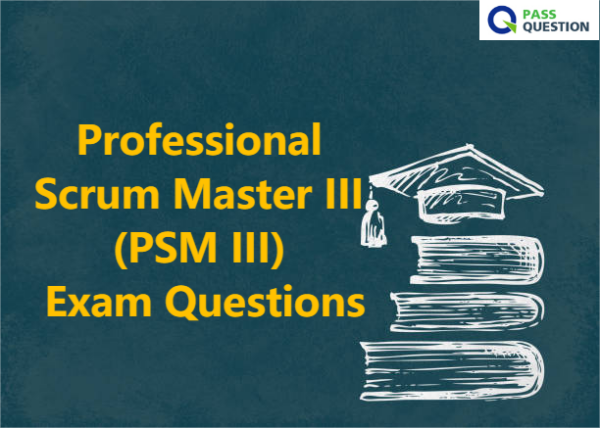Professional Scrum Master III (PSM III) Exam Questions
The Professional Scrum Master III certification, commonly known as PSM III, is considered Scrum's most elite certification. If you have passed PSM I and PSM II certification and have the ability to apply Scrum in complex organizational situations then this certification is right for you. The latest Professional Scrum Master III (PSM III) Exam Questions are newly cracked, which will be very helpful for your preparation for PSM III certification exam. Preparing through PassQuestion Professional Scrum Master III (PSM III) Exam Questions will enhance your knowledge and make you confident about the actual exam. By learning these Professional Scrum Master III (PSM III) Exam Questions, you will be able to understand the exam objectives of the actual exam and help you obtain remarkable progress in your PSM III exam preparation.

Professional Scrum Master III (PSM III) certification
People who have passed PSM III, achieving certification, demonstrate a distinguished level of Scrum mastery. The Professional Scrum Master III (PSM III) certification validates your deep understanding of how to apply Scrum, Scrum practices, and Scrum Values. PSM III tests your ability as a Scrum Master in a variety of complex team and organizational situations. Earning PSM III requires a very high level of Scrum knowledge and extensive experience as a Scrum Master.
Possessing a PSM I and PSM II certification is not required, but they are strongly recommended. Evidence shows it is important to pass the PSM I and PSM II to get a good baseline of your level of knowledge. Anyone scoring below 90% on the PSM I and PSM II will find earning the PSM III very difficult.
Exam Details
$500 USD per attempt
Passing score: 85%
Time limit: 150 minutes
Number of Questions: 30
Format: 80% essay, 20% multiple answers.
Difficulty: Expert
Recommended certifications: PSM I, PSM II
Exam Topics
Scrum Framework
Scrum Theory and Principles
Cross-Functional, Self-Managing Teams
Coaching and Facilitation
View Online Professional Scrum Master III (PSM III) Free Questions
1. At the seventh Sprint Review, the stakeholders are disappointed and angry. They have determined that the product or system being built will not meet their needs and will cost more than they are willing to spend. Which of the following statements could be true?
A. The PMO has not been engaged adequately.
B. The stakeholders haven't been attending prior Sprint Reviews.
C. The stakeholders haven't been using the Sprint Reviews to inspect and evaluate progress in the prior Sprint Reviews.
D. The Scrum Master has not ensured that the project is transparent
E. The Product Owner has not been keeping the stakeholders aware of the progress of the project.
Answer: B,C,E
2. A Project Manager working with your Scrum Team has raised concerns about progress and money spent. What are the best responses?
A. Have a discussion with the Project Manager; share the current impediments and forecast for the Sprint
B. Scrum doesn’t have Project Managers so disregard their concerns
C. Share the last stakeholder briefing document prepared by the Product Owner
D. Promote transparency by sharing the Product Backlog and ensuring the Project Manager has access
E. Show the Earned Value Analysis (EVA) report
Answer: A, D
3. In Scrum, we use the term "Forecast" when planning. Why is that?
A. Forecasting is part of the Scrum Framework, emphasizing its importance and preventing those new to Scrum from leaving it out.
B. It brings awareness to the fact that when planning, the team is looking ahead and not everything is certain. The team cannot commit to the plan not changing, it's a prediction based upon what is known today.
C. It emphasizes the difference between Scrum and plan-driven approaches.
D. Using the term Forecasting raises transparency because it is a term common to project and process methodologies.
Answer: B
4. It has been a year, a new product is under development and you joined the Scrum Team as their Scrum Master. The product is working software that has been delivered each sprint, but not released to the market. Recent pressure from within the organization and Stakeholders is forcing a release two months from now. The Product Owner feels this is premature as the work to be done before she has confidence in a release, is forecast to take at least six months. She appears quite distressed. What advice or help, in line with Scrum, can you offer?
A. Advise the Product Owner to work with the Stakeholders.
B. Advise the Product Owner to create more teams to work on the product. The new teams can lean on expertise from the original team.
C. Advise the Product Owner that the whole of the organization must respect her decisions. Stick to the current product vision and six-month timeline.
D. Advise the Product Owner to sit with the team and rescope the work planned. What can be delivered in two months that will meet customer needs? What would we need if we had to release this sprint?
Answer: A, D
5. While often associated with Scrum, which of the following practices DON'T complement Scrum?
A. Burn-downs, Burn-ups, or Cumulative flows
B. Definition of "Done"
C. Product Backlog Refinement
D. Hardening Sprint
E. Sprint Goal
F. Sprint 0
G. Definition of Ready
Answer: D, F
6. Why is Scrum referred to as a framework?
A. You can use the elements needed for it to best perform in your organization.
B. It needs all of its components to work as intended.
C. It is a foundation upon which other processes and techniques can be employed.
D. It is easy to learn but difficult to master.
Answer: C
- TOP 50 Exam Questions
-
Exam
All copyrights reserved 2025 PassQuestion NETWORK CO.,LIMITED. All Rights Reserved.

